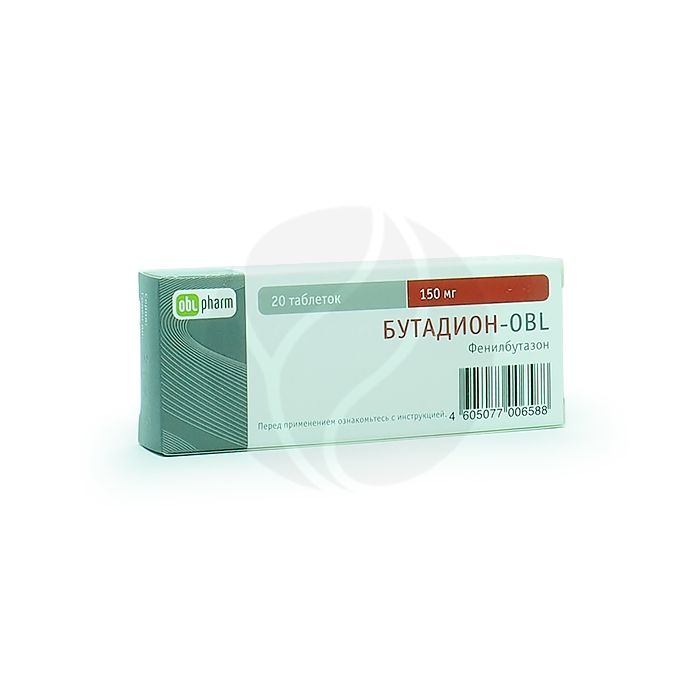Butadion - OBL tablets 150mg, No. 20
Expiration Date: 11/2025
Russian Pharmacy name:
Бутадион - OBL таблетки 150мг, №20
Inflammatory and degenerative diseases of the musculoskeletal system: rheumatoid, gouty, psoriatic arthritis, ankylosing spondylitis (ankylosing spondylitis), osteoarthritis.
Pain syndrome: bursitis, tendovaginitis, arthralgia, myalgia, neuralgia, dental and head (including migraine) pain, algomenorrhea, pain in trauma, burns.
Designed for symptomatic therapy, reducing pain and inflammation at the time of use, does not affect the progression of the disease.
Inside, for adults, 150 mg during or after meals 3-4 times a day. Children from 12 years old, 75 mg up to 4 times a day. The duration of therapy is determined by the severity of the condition.
Active ingredient: phenylbutazone 150 mg;
excipients: potato starch, sodium bicarbonate, magnesium stearate, colloidal silicon dioxide (aerosil), talc, croscarmellose sodium (primellose).
Hypersensitivity;
complete or incomplete combination of bronchial asthma, recurrent polyposis of the nose and paranasal sinuses and intolerance to acetylsalicylic acid or other non-steroidal anti-inflammatory drugs (including a history);
erosive and ulcerative lesions of the gastrointestinal tract in the acute stage (peptic ulcer and 12 duodenal ulcer, ulcerative colitis, peptic ulcer),
bone marrow depression
decompensated chronic heart failure or pulmonary heart failure,
severe hepatic and / or renal impairment (creatinine clearance less than 30 ml / min),
period after coronary artery bypass grafting;
progressive kidney disease
active liver disease
confirmed hyperkalemia,
pregnancy (III trimester),
active gastrointestinal bleeding,
inflammatory bowel disease
children under 12 years of age.
Carefully:
Hyperbilirubinemia, bronchial asthma, chronic heart failure, edema, arterial hypertension, hemophilia, hypocoagulation, liver failure, chronic renal failure, hearing loss, pathology of the vestibular apparatus, blood diseases, diabetes mellitus, systemic lupus erythematosus, rheumatic polymyalgia, transient arteritis, gastrointestinal tract, stomatitis, ischemic heart disease, cerebrovascular disease, dyslipidemia / hyperlipidemia, peripheral arterial disease, smoking, creatinine clearance less than 60 ml / min, history of ulcerative lesions of the gastrointestinal tract, presence of Helicobacter pylori infection, old age, long-term use of non-steroidal anti-inflammatory drugs, alcoholism, severe somatic diseases,simultaneous intake of oral glucocorticosteroids (including prednisone), anticoagulants (including warfarin), antiplatelet agents (including acetylsalicylic acid, clopidogrel), selective serotonin reuptake inhibitors (including citalopram, fluoxetine , paroxetine, sertraline), I-II trimester of pregnancy, lactation.
Pharmacological properties:
Non-steroidal anti-inflammatory drug; has anti-inflammatory, analgesic and antipyretic effects associated with the suppression of the activity of cyclooxygenase 1 (COX1) and cyclooxygenase 2 (COX2), which regulate the synthesis of prostaglandins. Shows uricosuric action.
Pharmacokinetics:
When taken orally, absorption is high; bioavailability - 85-90%, decreases with prolonged use. The time to reach the maximum concentration (TCmax) is 1-2 hours. The connection with plasma proteins is more than 95%.
It is metabolized in the liver to form 2 main metabolites. The half-life (T1 / 2) is 18-24 hours. It is excreted by the kidneys 70% (5% unchanged), through the gastrointestinal tract - 30% in the form of metabolites, excreted in significant quantities in breast milk.
Side effects:
From the digestive system: dyspepsia, NSAID-gastropathy, abdominal pain, nausea, vomiting, heartburn, diarrhea or constipation; with prolonged use in high doses - ulceration of the mucous membrane of the gastrointestinal tract, aphthous stomatitis, glossitis, erosive esophagitis, bleeding (gastrointestinal, gingival, hemorrhoidal), liver dysfunction.
From the side of the cardiovascular system: increased blood pressure, tachycardia.
From the nervous system: headache, dizziness, drowsiness, depression, agitation.
From the senses: hearing loss, tinnitus.
From the side of hematopoiesis: agranulocytosis, leukopenia, anemia, thrombocytopenia.
Allergic reactions: skin rash, itching, urticaria, bronchospasm, edema syndrome, angioedema.
Others: increased sweating, uterine bleeding.
Overdose:
Symptoms: cyanosis of fingertips, lips, body skin, dizziness, headache, increased or decreased blood pressure, hyperventilation of the lungs, clouding of consciousness, in children - myoclonic convulsions, nausea, vomiting, abdominal pain, hemorrhages, impaired liver and kidney function ...
Treatment: gastric lavage, the introduction of activated carbon, symptomatic therapy aimed at maintaining the vital functions of the body. Forced diuresis and hemodialysis are ineffective.
Interaction with other medicinal products:
Enhances the action of indirect anticoagulants, antiplatelet agents, fibrinolytics, side effects of glucocorticosteroids and mineralocorticoids, estrogens, morphine, paraaminosalicylic acid, penicillin, hypoglycemic effect of sulfonylurea derivatives.
Reduces the effectiveness of uricosuric, antihypertensive drugs and diuretics.
Increases the concentration in the blood of lithium preparations, methotrexate.
Inducers of microsomal oxidation in the liver (phenytoin, ethanol, barbiturates, rifampicin, tricyclic antidepressants) increase the production of hydroxylated active metabolites.
Antacids and cholestyramine reduce absorption.
Myelotoxic drugs increase the manifestations of the drug's hematotoxicity.
Special instructions:
During treatment, it is necessary to control the picture of peripheral blood and the functional state of the liver and kidneys.
If it is necessary to determine 17-ketosteroids, the drug should be discontinued 48 hours before the study.
During treatment, one should refrain from engaging in potentially hazardous activities that require increased attention and speed of mental and motor reactions. To reduce the risk of developing adverse events from the gastrointestinal tract, the minimum effective dose should be used in the shortest possible short course.

